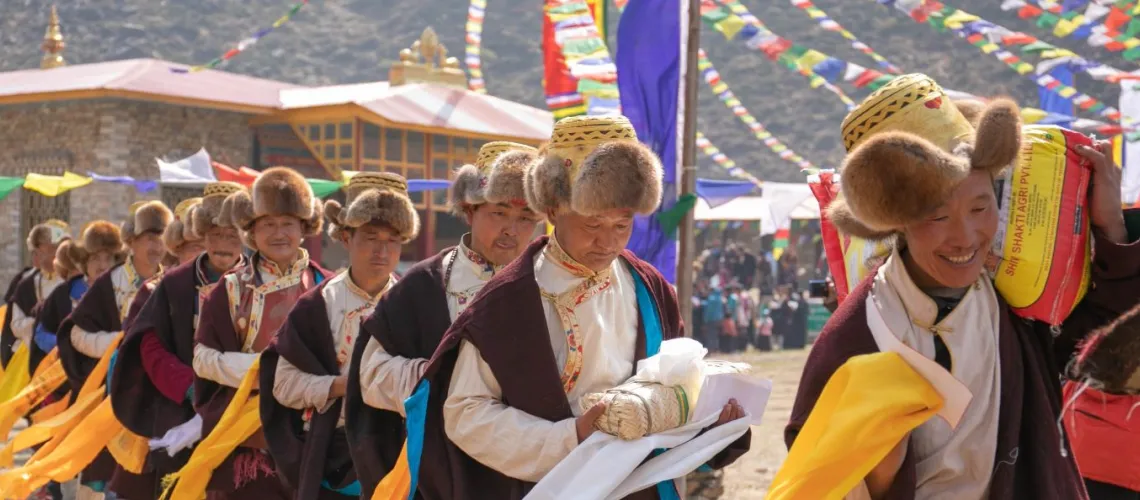As climate change accelerates, the World Bank is ramping up its support for Green, Resilient, and Inclusive Development (GRID) to help countries become more climate resilient. This includes a specific focus on Indigenous Peoples who are among the most vulnerable to climate shocks, and also play a critical role in sustainably managing natural resources; Much of the world’s remaining forests, for example, are found in indigenous territories.
Indigenous People are resilient, equipped with knowledge and practices that have been passed down and adapted for generations that guide how they care for the landscapes and ecosystems that sustain their food systems, livelihoods, and cultures. As climate-related disruptions escalate globally, lessons can be drawn from Indigenous Peoples’ knowledge, practices, and adaptations. Understanding the importance of these practices allows external partners such as the World Bank to better support these communities.
The South Asia region is home to many Indigenous Peoples with rich, unique cultures who reside in some of the most remote landscapes. They are often vulnerable to climate-related risks and disasters.
In Pakistan, the Kalash people residing in the valleys of Chitral have a deep understanding of how to sustainably manage their natural environment.
In Pakistan, the Kalash people reside in the valleys of Chitral, in the Hindu Kush Mountain range. They rely on natural resources for food and livelihoods and have a deep understanding of how to sustainably manage their natural environment. Their traditional knowledge and practices emphasize forest and water conservation, use of local herbs for medicine and highlight the spiritual and cultural elements of the natural world. These and other forms of specialized knowledge have been passed down for generations.
For example, the local shepherds are the primary source of knowledge within the community on glaciers, forests, and mountains. The Kalash people use traditional practices such as the Suri Jagek through which they predict weather patterns and the likelihood of natural disasters through extreme conditions based on celestial observation. This practice is also used to determine the appropriate times for planting crops and serves as a base for the Kalash people’s social calendar including festivals and religious ceremonies.
Image


A Kalash woman demonstrates traditional weaving practice of the community. Photo credit: Center for Indigenous Peoples Research and Development
In Nepal, the indigenous Tsum community, who reside in the remote Tsum Valley in Gorkha, have championed environment conservation through their customary institution, Shagya, now legally recognized by the Government of Nepal. The Shagya is an institution that protects the Tsum’s natural surroundings, biodiversity, and culture. This includes a strict no-violence policy, prohibiting community members from hunting, selling livestock and any form of violence against animals. It also restricts members from burning in forests and mountains to ensure the protection of the flora and fauna of the valley.
In Nepal, the indigenous Tsum community has championed environment conservation through their customary institution, Shagya to protect the Valley’s natural surroundings, biodiversity, and culture.
In India, tribal groups like the Kondh in Orisha have successfully regenerated vast areas of local forests using traditional patrolling practices. Their success highlights the value of local knowledge systems, which are at risk of being lost if communities are restricted from accessing land and natural resources.
A critical link exists between Indigenous Peoples, their territories and local ecosystems, and their ability to navigate challenges which are a consequence of both natural and man-made barriers/disruptions. The vulnerability of these communities is further exacerbated when they lose access to land and natural resources that they have protected and depended on for generations, as well as when they are not included in decisions about the best way to manage those resources sustainably.
In September 2023, the World Bank, in collaboration with the Center for Indigenous Peoples Research and Development, organized a gathering of Indigenous thought leaders and experts from 14 countries around the region including India, Pakistan, and Nepal to discuss the drivers and enablers of Indigenous resilience. The event served as a platform to link indigenous communities from the region, share experiences of resilience building in their communities and provide recommendations on improving the articulation and understanding of Indigenous resilience in the context of climate and other external shocks.
In India, tribal groups like the Kondh in Orisha have successfully regenerated vast areas of local forests using traditional patrolling practices.
Indigenous thought leaders and experts highlighted the long history of indigenous resilience, emphasizing the vital contribution of indigenous knowledge systems and traditional governance systems in their perseverance. Access to resources and land is a critical element that enables the continuity of indigenous culture, traditions, and practices, as well as their ability to feed and support themselves. Indigenous representatives stressed the need for international organizations to improve their own understanding of indigenous values, perspectives, and aspirations, and for interventions in Indigenous territories to be participatory and informed by these perspectives.
While much progress has been achieved in the recognition of indigenous identity in the region, stronger legal and institutional frameworks and their implementation are vital for ensuring Indigenous rights . Indigenous leaders raised the importance of indigenous participation in global climate-related negotiations and agreements, as well as their representation on climate financing programs and decision-making bodies.
In September 2023, the World Bank, in collaboration with the Center for Indigenous Peoples Research and Development, organized a gathering of Indigenous thought leaders and experts from 14 countries around the region including India, Pakistan, and Nepal to discuss the drivers and enablers of Indigenous resilience.
Understanding and strengthening Indigenous resilience will require meaningful engagement, consultation, and participation of Indigenous Peoples in climate actions. This will be crucial for delivering green, resilient and inclusive development strategies to prepare for future climate shocks.
——
Image


The terrain and the biodiversity of the Tsum valley in Nepal. Photo credit: Center for Indigenous Peoples Research and Development
The World Bank currently provides direct financing to empower Indigenous Peoples and local communities through the Dedicated Grant Mechanism, the Forest Carbon Partnership Facility (FCPF) IPLC Capacity Building Fund, and most recently through the Enhancing Access to Benefits while Lowering Emissions (EnABLE).
Source : World Bank Blogs





